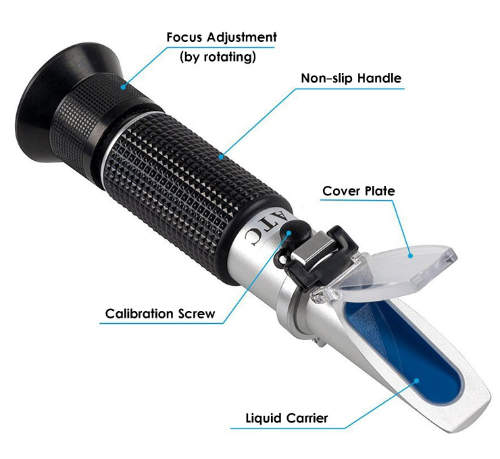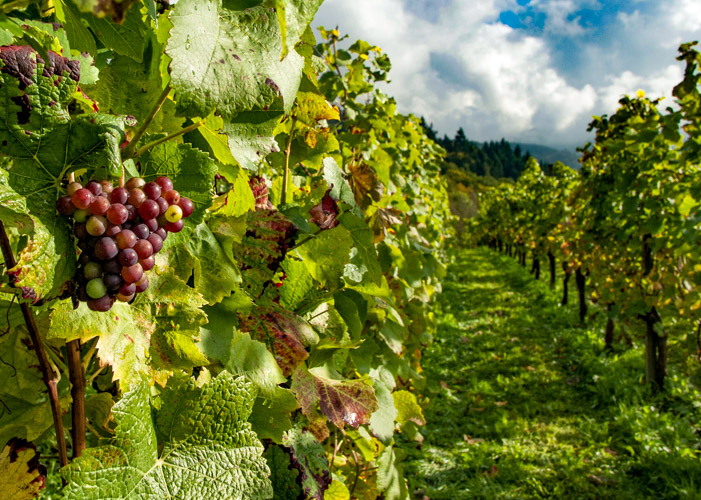If you are a wine lover, you may have heard of the term “brix”. But what does it mean and why measuring brix in grapes is important for grape growers and winemakers? In this blog post, I’ll explain what brix is, how it is measured, and what it tells us about the quality and potential of wine.
In simple words brix is a measurement of sweetness. But in more scientific terms, brix is a measure of soluble solids content in grapes. We measure brix using a refractometer. A refractometer measures the degree to which the light changes direction, called the angle of refraction. Each degree equals one gram of sugar per one hundred grams of grape juice. Brix is measured at grape harvest. Most table grapes are harvested having between 19 and 25 brix.
Brix is important because they indicate the ripeness and sugar level of grapes. Which will further determine how much alcohol a wine will have. Each gram of sugar that’s fermented will turn into about a half gram of alcohol. Of course, different winemaking techniques will affect the final alcohol content, which is why brix is interesting for wine explorers.
Brix and Wines
Brix can also tell us some secrets about how a wine was made. For example, if a wine has lower alcohol than the brix scale suggests, then it’s possible that the wine was diluted with water during vine making process. That means that some of the sweet grape juice was drained off and replaced with plain water. This technique is commonly practiced in warm climate regions. Where grapes become overly sweet by the time, they’re ready to be picked. The leftover, pinkish grape juice can be used to create a rosé wine called Saignée.
Another possibility is that the wine is sweet! For example, German law requires that all Spätlese Riesling wines have a minimum brix level of twenty. But many of the wines only have 7.5% alcohol by volume. In this case, you could assume that the wine would have about 75 g/L of leftover grape sugar, called residual sugar. By the way, 75 grams per liter is equal to about three teaspoons of sugar per five ounce (150 ml) serving.
On the other hand, if a wine has higher alcohol than the brix scale suggests, then it’s possible that the winemaker added sugar to the fermentation process to get higher alcohol levels for the wine. This technique is called Chaptalization and it’s commonly practiced in cooler climate countries such as France where it’s extremely hard to ripen grapes properly.
Measure Brix in Grapes
There are several tools available for measuring brix in grapes. One popular tool which grape growers and winemakers use is called refractometer. The refractometer measures dissolved sugar in a small juice sample in the field. Refractometers make it possible to determine the ideal time for grape harvesting so that the product arrives in an ideal state to consumers or for subsequent processing steps such as vinification.
To use a refractometer, you simply squeeze a drop of juice onto a glass plate and look through an eyepiece. The refractometer will show you a scale with numbers indicating the brix level of the juice sample. You can also use a hydrometer, which is a calibrated glass float used to measure the specific gravity (relative density) of liquids. A hydrometer can measure sugar content (brix) at any point during the winemaking process.
Grape Growing Practices Can Improve Brix
Grape growers can influence brix in grapes as well. That can be done by controlling the irrigation, pruning, canopy management, and harvest time.
- Irrigation affects the water content and concentration of sugars in the grapes.
- Pruning determines the number and size of grape clusters on each vine.
- Canopy management influences the exposure of grapes to sunlight and air circulation.
- Harvest time determines the ripeness and acidity of the grapes.
By effectively managing these factors, grape growers can optimize the brix in grapes for their desired wine style.
Conclusion
As you can see, brix and measuring brix in grapes is a useful and fascinating concept for anyone who loves wine and wants to learn more about how it is made. Brix can help you appreciate the complexity and diversity of wines from different regions, climates, and styles. Next time you sip on your favorite wine, you can impress your friends with your knowledge of brix!


